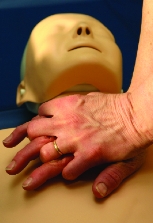Do CPR Chest Compressions Trump Rescue Breaths?

Cardiopulmonary resuscitation (CPR) training is a requirement for reputable fitness certifications and has been recommended by the American Heart Association for healthcare professionals and the general public for more than 35 years. About 900 Americans die every day from sudden cardiac arrest, so it is always advisable to keep track of suggested changes in the CPR protocol. A recent study from Japan indicates that chest compressions, not mouth-to-mouth resuscitation, are the key to success in helping a victim of cardiac arrest.
In the study, which appeared in the March 17 edition of The Lancet (2007; 369, 920–26), researchers analyzed 4,068 adult patients whose cardiac arrest was witnessed by bystanders. Of those, 439 received only chest compressions from the bystanders, and 712 received conventional CPR (compressions and rescue breaths). Twenty-two percent of those who received just chest compressions survived with good neurological function, compared with only 10% of those who received combination CPR.
In 2005 the American Heart Association revised its CPR guidelines to put more emphasis on chest presses, recommending 30 instead of 15 for every two rescue breaths. The organization said that studies had shown that “effective chest compressions create more blood flow through the heart to the rest of the body, buying a few minutes until defibrillation can be attempted or the heart can pump blood on its own.” The new guidelines recommend that rescuers “push hard and push fast” when giving chest compressions. Another advantage to dropping the rescue breaths, according to a comment in The Lancet, is that it could make bystanders more willing to provide CPR in the first place.
A Yahoo! Health news report mentions a caveat: the combination CPR in the study was given according to the old guidelines of 15 presses for every two breaths, not the 30 presses recommended now. According to this same article, the American Heart Association does not expect its advice to change. It recommends that bystanders provide compression-only CPR if they are “unwilling or unable” to do mouth-to-mouth breathing
at the same time.
To view the study and the comment on it, visit www.thelancet.com/webfiles/images/
clusters/thelancet/press_office/resusitation.pdf.
Joy Keller
Joy Keller is the director of marketing communications & PR at IDEA, and has also served as executive editor of IDEA Fitness Journal, IDEA Fitness Manager, IDEA Pilates Today, and IDEA Fit Business Success. She is also a certified personal trainer, indoor cycling instructor and yoga teacher (RYT 200).






